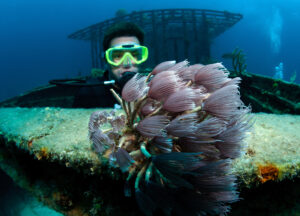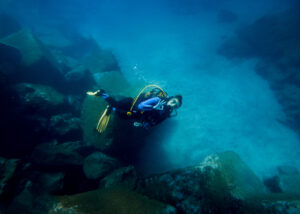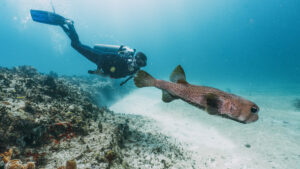What is Gas Blending?
Gas blending, a crucial process in scuba diving, involves mixing various gases to create a breathable mixture suitable for different diving conditions. This practice is essential for ensuring diver safety and enhancing dive performance, particularly in deeper or more prolonged underwater explorations. By carefully blending gases, divers can mitigate the risks associated with breathing high-pressure oxygen and nitrogen, such as oxygen toxicity and nitrogen narcosis. Gas blending has become a fundamental aspect of modern scuba diving, enabling divers to explore the underwater world more safely and efficiently.
Basics of Gas Blending
Gas blending in scuba diving involves combining different gases to create mixtures that meet specific diving requirements. The primary gases used in these mixtures are oxygen, nitrogen, and helium. Oxygen is essential for human respiration, while nitrogen and helium help manage the risks associated with high-pressure environments. The composition of these gas blends varies depending on the depth and duration of the dive, as well as the need for decompression.
The most common gas blends include air, nitrox, and trimix. Air, a natural mixture of approximately 21% oxygen and 79% nitrogen, is suitable for shallow dives but can become hazardous at greater depths. Nitrox, a blend of oxygen and nitrogen with a higher oxygen content than air, reduces the risk of decompression sickness and allows for longer bottom times. Trimix, a mixture of oxygen, nitrogen, and helium, is used for deep dives to prevent nitrogen narcosis and oxygen toxicity.
The practice of gas blending is driven by the need to optimize diver safety and performance. Different gas mixtures are tailored to specific diving scenarios, allowing divers to extend their underwater activities while minimizing the risks associated with breathing gases under high pressure. Understanding the basics of gas blending is fundamental for divers who wish to undertake more challenging dives.
History of Gas Blending
The history of gas blending dates back to the early days of scuba diving, when divers began to experiment with different gas mixtures to extend their underwater capabilities. In the mid-20th century, military and commercial divers started using oxygen-enriched air to enhance dive performance and safety. This practice laid the foundation for the development of modern gas blending techniques.
One of the significant milestones in the evolution of gas blending was the introduction of nitrox in the 1970s. Pioneered by NOAA (National Oceanic and Atmospheric Administration), nitrox blends were initially used for scientific and commercial diving. The benefits of using nitrox, such as reduced decompression times and lower nitrogen absorption, soon became apparent, leading to its widespread adoption in recreational diving.
The development of trimix in the 1980s marked another significant advancement in gas blending. Trimix, which includes helium in addition to oxygen and nitrogen, was designed for deep diving applications. The use of helium reduces the risk of nitrogen narcosis and oxygen toxicity, making it possible for divers to reach greater depths safely. These advancements in gas blending have significantly expanded the possibilities for underwater exploration and have become an integral part of modern scuba diving practices.
Principles of Gas Blending
Gas blending is based on several scientific principles that ensure the correct mixture of gases for safe and efficient breathing underwater. One of the fundamental principles is the concept of partial pressures, which refers to the pressure exerted by each gas in a mixture. The partial pressure of a gas is proportional to its concentration in the mixture and the total pressure of the gas blend. Understanding partial pressures is crucial for gas blending, as it allows divers to calculate the appropriate amounts of each gas to achieve the desired blend.
Accurate measurement of gases is essential for safe gas blending. This process involves using precise equipment to measure the pressure and concentration of each gas. Blenders must also account for factors such as temperature and humidity, which can affect gas volumes and pressures. By maintaining strict control over these variables, blenders can ensure the safety and effectiveness of the gas mixtures.
Another important aspect of gas blending is the use of safety margins. These margins provide a buffer to account for potential errors in measurement and calculation. For example, when blending nitrox, blenders often aim for a slightly lower oxygen concentration than the maximum allowable limit to ensure safety. Similarly, when blending trimix, the helium concentration is carefully adjusted to prevent nitrogen narcosis and oxygen toxicity at depth. Adhering to these principles is vital for producing reliable and safe gas blends for diving.
Methods of Gas Blending
There are several methods used in gas blending, each with its own advantages and applications. The most common methods are partial pressure blending, continuous flow blending, and membrane separation.
Partial pressure blending involves adding gases to a cylinder in a specific sequence to achieve the desired mixture. This method starts by adding the gas with the highest concentration, followed by the next highest, and so on. For example, when blending nitrox, oxygen is added first, followed by air to achieve the desired oxygen concentration. This method requires careful calculation of the amount of each gas to ensure the correct blend. Partial pressure blending is widely used due to its simplicity and accuracy, but it requires precise control of gas pressures and volumes.
Continuous flow blending, also known as constant flow blending, involves mixing gases as they are continuously added to a cylinder. This method uses flow meters to control the rate of gas addition, ensuring the correct proportions of each gas. Continuous flow blending is often used for producing large volumes of gas mixtures and can be more efficient than partial pressure blending. However, it requires more sophisticated equipment and careful monitoring to maintain accuracy.
Membrane separation is a more advanced method that uses semipermeable membranes to separate gases based on their molecular size and properties. This method is commonly used to produce nitrox by separating nitrogen from air, resulting in an oxygen-enriched mixture. Membrane separation is highly efficient and can produce a consistent gas blend without the need for complex calculations. However, it requires specialized equipment and is typically used in commercial settings rather than by individual divers.
Each of these methods has its own set of advantages and disadvantages, and the choice of method depends on factors such as the desired gas blend, the volume of gas required, and the available equipment. Understanding the different methods of gas blending is essential for producing safe and effective gas mixtures for diving.
Equipment Used in Gas Blending
Gas blending requires specialized equipment to ensure the accurate and safe production of gas mixtures. The key components of gas blending equipment include compressors, cylinders, and blending panels.
Compressors are used to compress gases to high pressures, allowing them to be stored in cylinders for use during diving. There are different types of compressors, including air compressors and oxygen compressors, each designed for specific gases. Maintaining and regularly inspecting compressors is essential to ensure their reliability and safety.
Cylinders, also known as tanks, are used to store the blended gases at high pressure. These cylinders are made from materials such as aluminum or steel and are designed to withstand the pressures associated with compressed gases. Proper maintenance and inspection of cylinders are crucial to prevent failures and ensure diver safety.
Blending panels, also known as mixing panels, are used to control the addition of gases during the blending process. These panels are equipped with gauges, flow meters, and valves that allow blenders to accurately measure and mix gases. The design and configuration of blending panels can vary, but they all serve the same purpose of ensuring precise control over the gas blending process.
In addition to these primary components, other equipment such as analyzers, regulators, and hoses are used to support gas blending. Analyzers are used to measure the concentration of gases in the blend, ensuring accuracy and safety. Regulators control the pressure of gases during blending, while hoses are used to transfer gases between different components.
Maintaining and regularly inspecting all gas blending equipment is essential to ensure the safety and quality of the gas mixtures. Any malfunction or failure in the equipment can result in inaccurate gas blends, posing serious risks to divers. Therefore, adhering to proper maintenance protocols and safety checks is critical in the gas blending process.
Safety Considerations in Gas Blending
Safety is paramount in gas blending, as improper mixtures can lead to serious health risks and accidents. One of the primary risks associated with gas blending is oxygen toxicity, which occurs when divers breathe gas with too high an oxygen concentration at depth. Oxygen toxicity can cause symptoms such as seizures and loss of consciousness, which can be life-threatening underwater. To prevent oxygen toxicity, it is crucial to accurately measure and control the oxygen concentration in gas blends.
Another significant risk is nitrogen narcosis, which occurs when divers breathe nitrogen at high pressures, causing symptoms similar to alcohol intoxication. Nitrogen narcosis can impair judgment and motor skills, increasing the risk of accidents. Using helium in gas blends, such as in trimix, can help mitigate the effects of nitrogen narcosis.
Proper training and certification are essential for anyone involved in gas blending. Training programs cover the principles of gas blending, the use of blending equipment, and safety protocols. Certification ensures that blenders have the necessary knowledge and skills to produce safe gas mixtures. Divers using gas blends should also be trained in the use of these mixtures and aware of the associated risks.
Regular maintenance and inspection of gas blending equipment are critical for safety. Compressors, cylinders, and blending panels should be regularly checked for signs of wear and damage. Any malfunctioning equipment should be repaired or replaced immediately to prevent accidents. Additionally, using high-quality and properly calibrated analyzers is essential for accurately measuring gas concentrations.
Adhering to established safety protocols and best practices is vital in gas blending. This includes using safety margins in gas calculations, performing regular equipment checks, and ensuring proper training and certification. By following these guidelines, the risks associated with gas blending can be minimized, ensuring the safety of divers.
Applications of Gas Blending in Scuba Diving
Gas blending has a wide range of applications in scuba diving, catering to the needs of recreational, technical, and commercial divers. In recreational diving, gas blends such as nitrox are commonly used to extend bottom times and reduce the risk of decompression sickness. Nitrox allows divers to spend more time at depth without exceeding safe limits, making it a popular choice for extended dives.
Technical diving, which involves deeper and more complex dives, often requires the use of gas blends such as trimix. Trimix blends, which include helium, reduce the risks of nitrogen narcosis and oxygen toxicity, allowing divers to reach greater depths safely. Technical divers also use gas blends for decompression, ensuring safe ascent from deep dives.
In commercial diving, gas blending is used for a variety of underwater tasks, such as construction, inspection, and maintenance. Commercial divers often work at significant depths and for extended periods, requiring specialized gas blends to ensure their safety and efficiency. The use of gas blending in commercial diving has enabled the completion of complex underwater projects that would not be possible with standard air.
The versatility of gas blending makes it an essential tool in modern scuba diving, providing solutions for a wide range of diving scenarios. By tailoring gas mixtures to specific needs, divers can optimize their performance and safety, whether they are exploring recreational dive sites, undertaking technical dives, or working on commercial projects.
Key Takeaways
Gas blending is a critical aspect of scuba diving that enhances safety and performance by creating customized breathing gas mixtures. Understanding the basics, history, principles, methods, equipment, and safety considerations of gas blending is essential for divers and blenders alike. Proper training, maintenance, and adherence to safety protocols are crucial in ensuring the reliability and effectiveness of gas blends. By mastering the art of gas blending, divers can safely extend their underwater adventures and tackle more challenging dive environments.

















